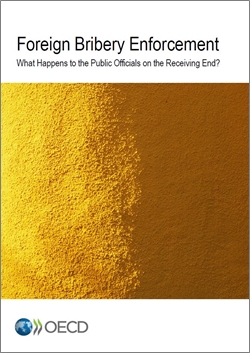|

DATE OF PUBLICATION
11 December 2018
Further reading
Enforcement Survey: What happens to public officials who take bribes?, Katie Gordon and Brooks Hickman
Taking the fight against corruption to the demand side of bribery, Klaus Moosmayer
|
|
The OECD Anti-Bribery Convention is the foremost global legal instrument for fighting the supply side of foreign bribery. The supply side of foreign bribery relates to what bribers do – it involves offering, promising or giving a bribe to a foreign public official to obtain an improper advantage in international business. In contrast, the demand side of foreign bribery refers to the offence committed by public officials who are bribed by foreign persons.
This study explores whether there is a "flip side" to enforcement actions that ended in sanctions for the supply-side of a foreign bribery transaction. It focuses on what happened on the receiving end of this transaction. That is to say, were the public officials in the demand-side country also sanctioned or otherwise disciplined?
The study was launched on 11 December 2018 at the OECD Working Group on Bribery's annual consultation with the private sector and civil society.
MAIN FINDINGS
More must be done to effectively sanction public officials accepting bribes
11/12/2018 - Public officials accepting bribes from OECD-based companies run little risk of being punished, according to a new OECD report. The report looks at what happened to the public officials in a set of 55 concluded cases between 2008 and 2013 where OECD-based companies were punished for bribing foreign public officials
In only one fifth of the 55 concluded foreign bribery cases were formal sanctions imposed on one or more public officials. This is particularly striking because it is for cases in which both sides of the bribe transaction – the briber and the public official on the receiving end – were subject to the jurisdiction of Parties to the OECD Anti-Bribery Convention, a group of countries that have relatively advanced law enforcement and public sector management capabilities.
The report notes that:
- Enforcement actions targeting public officials do take place, but the rate of sanctioning is not particularly high. As noted above, sanctions were imposed on at least one public official in only one fifth of the 55 cases. However, in 30 cases, an investigation took place and, of these, a criminal enforcement action against one or more public officials (e.g. prosecution) was launched in 20 cases. Interestingly, despite the 2013 cutoff date, 11 of the cases against public officials were still pending, either at the investigative or prosecutorial stages. Thus, overall, sanctioning takes place at a lower rate than one might expect (or hope) given that this is for a sample of cases in which it is known that bribery took place.
- International co-operation is not a major source of detection for demand-side cases. Somewhat surprisingly, co-operation between law enforcement authorities in the demand-side and supply-side jurisdictions reportedly did not play any role in detecting allegations in the cases covered by the survey. According to the survey responses, none of the enforcement actions involving public officials were detected through direct communications with supply-side enforcement authorities.
- The media play a major role in the international flow of information. The media were the dominant reported source of detection on the demand side. In many cases, the media apparently accessed information posted by the supply-side enforcement authorities and made it available in the demand-side country. Thus, the media not only informed the general public, but also served as an intermediary in information flow between the supply-side and demand-side enforcement authorities.
- Enforcement capacity needs to be enhanced. When public officials were not sanctioned, this was often attributed to standard problems encountered in criminal law enforcement. Examples cited include insufficient evidence (5 cases) and statute of limitations (4 cases). In one case, key documents disappeared from the ministry associated with the bribe. Finally, the machinery of justice appears to move slowly in some countries -- despite the fact that the cut-off date for inclusion of cases in the survey was 2013, five cases were still pending at the stage of investigation and six at the stage of prosecution.
|
